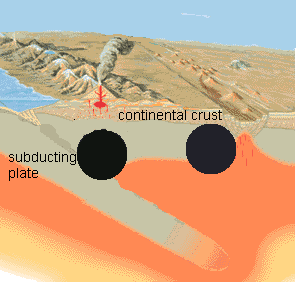|
The formation of granite is a complex process. It can
be explained by plate tectonics. Almost all granite forms at convergent
plate boundaries where subduction is taking place. Subduction is the
downward plunging of one plate under another. Granite forms in two
steps. In the first step, the subducting plate dives into the Earth’s
mantle, heats up and begins to melt. This creates magma. Magma rises,
and causes melting in the rock above it, making more magma. When this
magma cools, it makes igneous rocks like diorite, not granite.
In the second step, subduction, melting, and magma
formation continue. However, when the magmas formed in this step rise
upward, they cause part of the diorite formed in the first step to begin
to melt. This, combined with melting of surrounding sedimentary and
igneous rocks, makes magma which cools to become granite.
|

Areas of granite formation
|